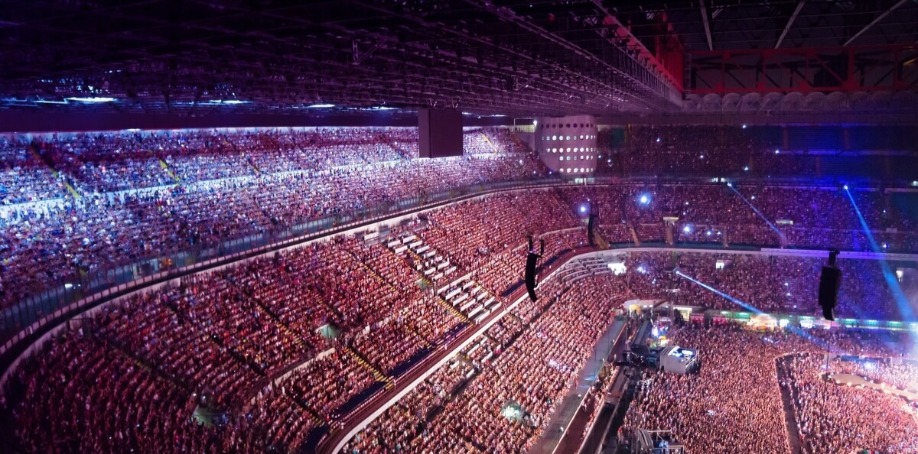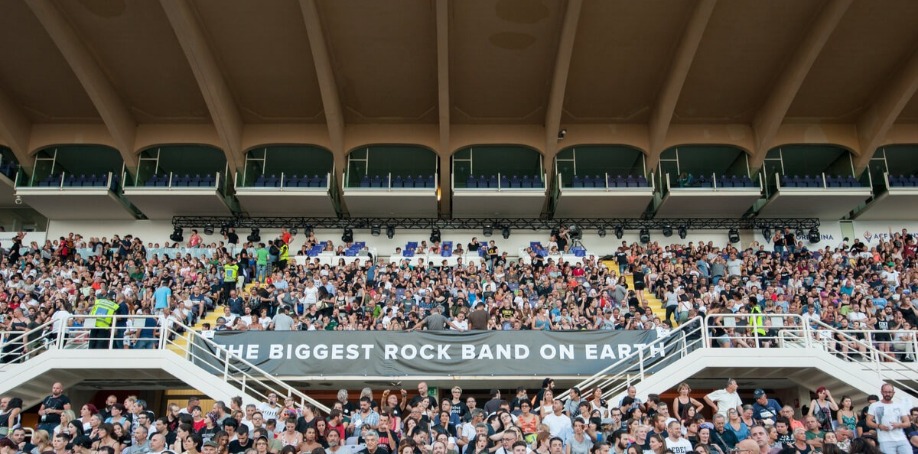
How do you design a building that can encompass a soccer match, a football game, or a rock concert? Chances are, the building that appears in blueprints will be deep and wide and filled with seating. A large, reflective space like a stadium or an arena comes with specific sound-engineering challenges, even if you're using audio over IP (AoIP) technology. We'll outline a few of those issues (and their solutions) here.
Stadium Spectator Experiences Are Changing
Cast your mind back to the Roman era. Spectators streamed into an area expecting a spectacle of sight and sound. Better seats came with superior views. Modern arena visitors have similar expectations, but there are a few important differences.
"You're designing for a multitude of experiences and a number of choices that a fan can have versus what historically might have been a more singular experience in the way that you come to the venue, go to your seat, watch the game and then leave," says Ryan Gedney, national design director at infrastructure solutions firm HNTB.
A modern spectator watches the live action. But that person might also watch images unfold on huge screens mounted above the scene, and those same images might appear on other screens scattered around the venue, at the entrance and food courts and other common areas. AoIP makes those multiple outputs simple.
"From the VIP suites to the food court and parking lot, the audio system is required to sound uniform and be uninterrupted. This is including audio visual in the restrooms. All of this is now possible with system manufacturers like us providing a total system solution using an IP-based system," explains Oliver Sahm, director of tech support at Bosch Security.
AoIP's versatility means audio can push to anything connected to the network, and hooking up new receivers is easy. But audio engineers will need to adjust their configurations as the events change.
”We also have concerts, religious events and the annual NFL games. It was essential that we have intelligible audio in every seat, with the power and clarity needed to deliver a complete watching and listening experience alongside the HD screens," says Alejandro Aguirre, Azteca Stadium’s audio manager.
An AoIP system can't be a set-it-and-forget-it affair. With enhanced opportunities come advanced expectations.

Crowds Are Loud
Spectators are rarely silent. They cheer when something amazing or inspiring happens, and groan or wail to express displeasure or put an opposing team at a disadvantage. In a large, reflective space, the sound of a crowd can reverberate and build. It can even be deafening — and sometimes, that seems ideal.
The team at Albrecht Audiology gives this example of when increased crowd noise can be used to a sports team's advantage: "When Penn State had the ball, sound levels were consistently in the 80-90 dB range (the sound level of a lawnmower) but rose to over 100 dB (rock concert level) when the opposing team had the ball. After more analysis of the sound level and the acoustics of the stadium, Penn State decided to move the student section to the south end zone in 2011. This was done because the noise of the students cheering carries better from that area, increasing the sound on the field by as much at 50 percent."
But crowd noise can muffle important cues, and at times, ruin the experience. AoIP offers sound engineers the opportunity to adjust volume on the fly, so nothing gets missed.
New sound systems at a New Jersey high school made all the difference: “They had their opening night at the stadium a few weeks ago with a DJ and a full house. The ref wore a mic, and everything was clear, and the coverage was great. The big issue previously was being able to hear above the crowd noise and on the field, but that's no longer a problem with the new system,” says Joe DiSabatino, owner of JD Sound and Video.
Sound Spillage Can Vex Community Members
The noise from screaming fans doesn't always stay within the walls of a stadium or arena. Sometimes, the noise leaks out. Given that large performance spaces are often located in dense, urban areas, this can be a significant problem.
Modeling during installation can help. At times, though, additional research is required.
Hailey Bolliger covered a problem like this for City Beat. "A preliminary report by acoustics experts commissioned by the Cincinnati Arts Association has found that sounds from FC Cincinnati games played at the team's coming West End stadium will be audible inside Music Hall, home of the Cincinnati Symphony Orchestra and other arts organizations," she wrote.
In a situation like this, research alone won't help. Audio teams must act to appease all parties, and the solution doesn't have to be complex or cost prohibitive.
“It can be something as simple as the location and/or placement of speakers in a particular zone or geographic direction that can control how sound radiates in and out of the stadium and into adjacent neighborhoods,” explains John Laughlin, CEO and president of Conference Technologies.
Reverb is an Issue
Reflective spaces, like high ceilings, empty seats and bare floors, can allow sound waves to amplify. Reverberation is the result.
"Reverb is created when soundwaves from any sound source reflect off surfaces in a room, causing a large number of reflections to reach your ear so closely together that you can't interpret them as individual delays. The result is magnified in larger rooms where it appears that the sound continues after the source has stopped. The larger the room, the larger the potential reverb," writes recording engineer Kenneth Pearsall.
It's not always feasible to make the room smaller. The larger the venue, the more tickets (and revenue) a company can make. Architectural adjustments may help a bit. Panels and baffles scattered around the space can adjust reverb in a large, echoing room, according to the team at Acoustical Surfaces.
However, it's the materials used in the construction of performance spaces that play a big role. "There is little that can be done regarding construction materials like concrete and glass, which have highly reflective properties that can adversely affect the audio by increasing the 'tail time,' or the time it takes the audio energy to decay within the space," says Kevin Ivey, sports and entertainment project developer with Baker Audio Visual.
AoIP can help to cut down on the confusion and disruption reverberation causes. Sound engineers can combat the echoing sound with customized feeds that match the action as it happens. The result is spectators can hear the event as it unfolds, even as echoes of the past move around the room.
“One of the things I can do now is send 16 channels of audio to almost any place in the stadium up to the control room. It is very liberating,” says Jeff Pedersen, lead audio technician at the Minnesota Twins Baseball.

Phasing Problems Often Take Hold
What happens when the sights and sounds that surround you don't quite match? That's a phasing problem, and it's common in modern stadiums and arenas.
"Fans spend the bulk of time in their seats. To get them closer to the game, many stadiums are suspending gigantic display boards above the field, amplifying the spectacle," Chris Arkenberg, Pete Giorgio, and Chad Deweese write for Deloitte Insights.
A person at a football game might see the start of a touchdown run on the field, and then look up at the screen to watch the action closely. If the push is successful, the person might hear cheers come up from fans near the end zone seconds after the goal happens.
AoIP gives engineers the option to create sound arrays that deliver the sound from the field to a spectator in the seats. But balance is critical, as fans might switch from looking from field to screen and back again. Designing the proper array is important.
"Let's say I'm putting the line array up above the scoreboard in the middle of a basketball arena. The top box may be aimed at the top five rows of the stadium. The box below it would be angled two degrees lower and aimed at the next five rows. The next box below that would be aimed at the next five, and all the way down. It's that specific," says Kenneth Voss, manager of installed sound and media relations director at audio equipment manufacturer RCF.
The programming for each speaker could be slightly different, so the sound changes depending on the spectator's position relative to the field.
Control Considerations
Managing sound in a large space is a combination of science and art. Technology helps improve the experience, but in the end, engineers make the final choices that dictate what the room sounds like.
“You cannot replace human hearing and what a trained and experienced ear can discern, when it comes to audio quality and things like artifacts. You can turn a sound person into an IT technician with training, but doing the reverse is a lot harder. As IP gets deeper into live sound, it argues for a hybrid set of skills,” says Paul Murdick, general manager of TSI Global Companies.
As AoIP makes control easier, systems can also be far removed from the live action. For some engineers, that's ideal.
"We don't have a control room on-site at Camp Randall for the video board operations. The video board control room is actually at the Kohl Center, and there's a mile of fiber that runs between the two buildings. Audio is transported from the Q-Sys system at the Kohl Center to the Q-Sys system at Camp Randall via Core-to-Core streaming. It's pretty awesome; to be able to stream under the city streets to the control room and have that type of atmosphere going on at the football stadium a mile down the road is pretty intense,” the University of Wisconsin's Athletic Department senior audio engineer Shay M. McElwain tells AV Magazine.
Images by: yobro10/©123RF.com, ilfede/©123RF.com,zummolo63/©123RF.com


